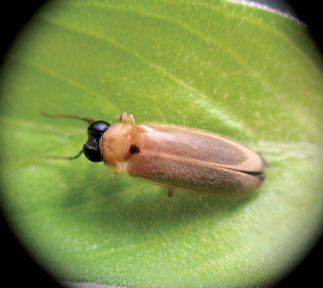|
Lighting bugs
A fascinating study
by Firefly research group
W.M.C.D.Wijekoon, Dr. H.C.E.Wegiriya and Dr. C. N. L. Bogahawatte
Department of Zoology, University of Ruhuna.
Fireflies or “Lightning bugs” are the synonym given to this important
group of insect. They are distributed worldwide with the greatest
diversity of species occurring in the Oriental and the Neotropical
regions of the world. Seven subfamilies inhabit in tropical and
temperate regions.
|
The light emitting
frequency and colour of light producing vary in different
species of fireflies. In most firefly species both sexes have
the flying ability, while in several species only the male can
fly and the females are wingless and worm like, similar to their
“larvae”. Though, they cannot fly, they have light
emitting organs for searching food and mates in the dark |
 |
Two hundred and eighty species of fireflies have been recorded in
Asia including 30 species from Sri Lanka. A reference firefly collection
is also available in the National Museum, Colombo. If you are interested
to see fireflies, you have to wait until 6.00 p.m. To ensure the best
sightings of the visual displays of fireflies.
Their fascinating, automatically on, off light signalling pattern
will be helpful to recognise even different individuals clearly at
night. Studies revealed that they mostly inhabit in water associated
open habitats and less visible in highly sheltered forest habitats.
However, after 8.00 p.m. they gradually move to tree tops to show
their lightning behaviour to many members of their group. Definitely,
the light emitting process is helpful to search their mates. So they can
quickly find suitable partners in the dark and move towards them. It is
indeed an elegant scene at night. Fireflies have their light emitting
organ or “lantern” at the end of their abdomen. The male has two
lanterns and the female has only one.
The light emitting frequency and colour of light producing vary in
different species of fireflies. In most firefly species both sexes have
the flying ability, while in several species only the male can fly and
the females are wingless and worm like, similar to their “larvae”.
Though, they cannot fly, they have light emitting organs for
searching food and mates in the dark.
These wormlike females and larvae are known as “glow worms”.
The well-known nocturnal crawler Re badulla is a real example for
these wingless fireflies. There is a general belief among vegetable
farmers in Sri Lanka, that fireflies are minor pests which feed on
leaves of their crops. But, experts have discovered that, most adult
fireflies do not feed at all.
They obtain energy during the larval stage and that energy is enough
for the survival of the adult.
The firefly larva is a voracious predator, preying on snails, grubs,
cutworms, and other soil-dwelling invertebrates. They inject their prey
with neurotoxins and digestive enzymes that paralyze and break-down the
body tissues, then consume the liquefied remains.
Fireflies play a significant ecological role in our environment. The
number of lanterns are the main indicators of the sex.
Their light flashing behaviour, fireflies are increasingly studied
for their use in night Zoos as an ecotourism subject. In addition, the
bioluminescence in fireflies is being investigated thoroughly in the
developed countries to find nanotechnological solutions to many unsolved
problems, especially in medical sciences.
Their pulses of light represent a conspicuous signal that has been
shown to function as an aposematic defense, which warns predators of
distastefulness and unpallatability.
Several research studies have shown that ingesting fireflies can be
lethal to lizards and frogs. In addition, fireflies are also important
as general predators, feeding on insects and other invertebrates, some
of them are well-known pests of various crops.
Fireflies are one of the least concern insect groups in Sri Lanka.
Most of us have very poor knowledge about fireflies and their behaviour.
Even we have not updated our Taxonomic records on fireflies which
were collected in the eighteenth century.
Since 2007, researchers of the Department of Zoology, and the
University of Ruhuna have done some work on fireflies in Sri Lanka based
on their taxonomy and ecology.
Apparently, fireflies in the world have threatened by various human
activities on the environment.
Thus, we must renew the existing old but valuable information of
fireflies in Sri Lanka, and conduct further research concerning their
ecology and behavior for conservation of species threatened due to
various anthropological activities.
As such, we must take steps today, to conserve this valuable group of
insects.
We can conserve and learn about them by actively participating in
public awareness programs, especially among the local community
including school children and nature lovers.
Now is the time for scientists, naturalists and zoologists to spread
their research work concerning this important group of insect in Sri
Lanka. |

